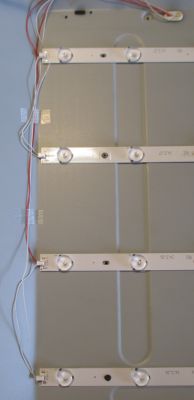FAQ
TL;DR: Backlight dead? Power each strip directly (32V, 0.94A lights a 32-inch strip); "I usually check each separately." Use this FAQ to test, source safe voltage, and revive Blaupunkt backlights. [Elektroda, gradek83, post #17231990]
Why it matters: It helps DIYers and bench techs diagnose and repair Blaupunkt LED backlights faster without guesswork.
Quick Facts
- Standby LED+ is ~35V; on enable it jumps near 90V, then drops if the driver detects a fault. [Elektroda, wentyl215, post #17225956]
- A dedicated LED tester (110–265V) quickly verifies long strings and full panels safely. [Elektroda, zdzich42, post #17231841]
- HP printer PSU option: 32V 0.94A and 16V 0.625A, enough to light a 32-inch strip. [Elektroda, gradek83, post #17231990]
- To expose marginal LEDs, light each string and gradually lower the voltage until one dims or shuts off. [Elektroda, Adewag, post #17228228]
- TV drivers expect a specific LED count and parameters; signage modules at 12V will not satisfy them. [Elektroda, Adewag, post #17476324]
Why does my Blaupunkt backlight spike to ~90V then fall back to ~35V?
The boost converter starts, raises LED+ near 90V, then senses an open or weak string. It shuts down to standby, around 35V. This points to at least one bad LED, a bad joint, or a mismatched load on a channel. Verify each strip independently before chasing the driver. Measure at the two LED connectors during power-on for confirmation. [Elektroda, wentyl215, post #17225956]
What’s the quickest safe way to test TV LED strips?
Use a purpose-built LED backlight tester. Units rated 110–265V can light single strips or full chains without the TV’s PSU. They simplify isolating a bad string and reduce bench wiring errors. [Elektroda, zdzich42, post #17231841]
How can I light a single strip with common parts?
Use an HP full-size printer power supply. It provides 32V at 0.94A, plus 16V at 0.625A. The 32V rail is enough to light a single 32-inch TV strip. Use sharp probes on pads or clip leads carefully to avoid shorts. [Elektroda, gradek83, post #17231990]
How do I find a weak LED when all light on the bench?
Use a controlled drop test to expose the weak point.
- Power one string at 25V so all LEDs light.
- Gradually lower the voltage while watching brightness uniformity.
- Replace any LED that turns off early or glows dimmer.
As one expert said, "supply each string separately with 25V and start gradually reducing the voltage." [Elektroda, Adewag, post #17228228]
Can I power both strip pairs at about 60V to check them together?
Yes. These sets pair strips on two connectors. Users propose testing each connector around 60V to confirm both pairs ignite. If you lack a 60V supply, use a backlight tester that reaches that voltage. Limit current while probing. [Elektroda, wentyl215, post #17227178]
Can I replace the backlight with 12V 3‑LED signage modules?
No. The driver expects a defined count of LEDs with specific forward voltage and current. Mismatched modules can trigger protection and shutdown. "The driver has to 'see' a certain number of LEDs with specific parameters." Use original-type strips or equivalent LEDs. [Elektroda, Adewag, post #17476324]
On startup I see about 100V flash and then 38V standby. What does that tell me?
The boost starts and then shuts down due to a load mismatch. One case used eight 12V modules (96V total) and saw ~100V flash, then 38V standby. Return to proper strips and verify each string’s continuity and load. [Elektroda, kiko_tychy, post #17473872]
Are connector joints a common failure point on these slats?
Yes. Breaks at inter-strip joints and connectors can open a string. Inspect and reflow those joints before deeper board work. Wiggle-test the harnesses at both LED sockets while watching voltage behavior. [Elektroda, zdzich42, post #17226381]
Should I disassemble the panel and replace only bad LEDs now?
Yes. Open the panel, find all weak or dead LEDs, and replace them in one pass. This minimizes the chance of a second disassembly. Test each string after reassembly for uniform light and stability. [Elektroda, czajnik23, post #17474610]
Which LED driver IC is on MSD309.BP85, and what should I check?
The LED driver is marked UB10 on this board. Users report it as OB3350. Review its datasheet for enable, PWM dimming, and current-sense pins before measuring. Confirm the marking and consult the documentation. [Elektroda, wentyl215, post #17229181]
Why does a diode like DB13 read both ways, or an 1117 LDO show GND‑Vout continuity?
In-circuit readings can mislead due to parallel paths. The DB13 pads still showed continuity with the diode removed. The 1117B at UL1 measured ground-to-Vout continuity during power-up. Lift parts or isolate pads to verify genuine faults. [Elektroda, wentyl215, post #17228736]
My strips light at 25–30V externally, but the TV still has no backlight. Why?
External supplies can light strings even when one LED is marginal. The TV driver senses imbalance or insufficient headroom and shuts down. "Together or separately they will shine from an external power supply." Replace the weak diode using the voltage‑reduction test. [Elektroda, Adewag, post #17228228]
How many strips and LEDs does the Bla‑40/133L use?
A field report notes four strips, about ten LEDs per strip, with strips paired per connector. Each strip lit at 25–30V during bench tests. Use ~60V to check a pair if required. [Elektroda, wentyl215, post #17242231]
Are LED testers worth buying for this repair?
Yes. Community members describe LED testers as the normal way to work now. They validate strips and arrays quickly without risky improvised setups, speeding diagnosis and reducing repeat disassembly. [Elektroda, piotrus196, post #17227233]
What tester features help me avoid damaging LEDs?
Pick a tester with volt and amp display and adjustable current. Limiting current reduces stress while probing long strings. A current knob also reveals a weak diode as brightness sags sooner than neighbors. [Elektroda, czajnik23, post #17227953]




